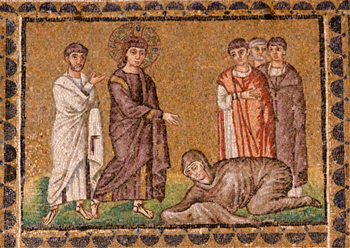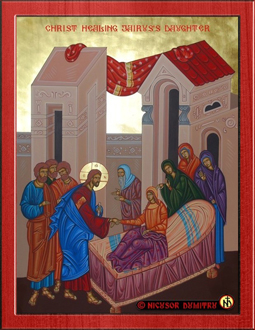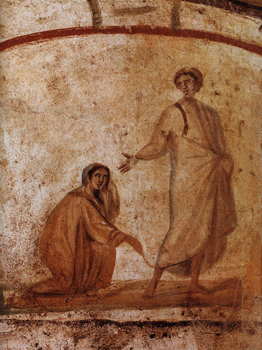For Sunday July 1, 2018
Lectionary Readings (Revised Common Lectionary, Year B)
Lamentations 3:22-33
Psalm 30
2 Corinthians 8:7-15
Mark 5:21-43
There aren’t many Bible verses that bring tears to my eyes as quickly as the one that lies at the heart of this week’s Gospel reading: “But the woman, knowing what had happened to her, came in fear and trembling, fell down before Jesus, and told him the whole truth.”
According to St. Mark, the woman had been bleeding for twelve years. Her condition rendered her ritually unclean — not just for a day or a week or a month, but indefinitely. She could not enter the Temple, the heart and soul of her religious community. She could not touch or be touched by anyone without rendering them unclean, too. By the time she approached Jesus, she had spent every penny she owned, and “endured much under many physicians” to find relief, but her bleeding had only worsened. The woman’s very body — its femaleness, its porousness — had become a source of isolation and disgrace. She was an outcast, an embarrassment, a pariah. Lonely beyond description.
And so it might have remained if the woman hadn’t — in a desperate and stunning act of civil disobedience — defied the religious rules of her day to pursue an encounter with Jesus. She knew she had no business polluting the crowds with her presence. She knew she was forbidden to touch any man, least of all Jesus. She knew that even her fingertips on his cloak would defile him. She decided to touch him, anyway.
 |
If the story ended there — with a stolen touch, an unremarked healing, and an invisible but still potent transformation of the woman’s life — I would consider it miracle enough. But no. Jesus invited more. He insisted on more. He insisted that the woman, terrified though she was, come forward and tell her story. Her “whole truth.” He knew that she had spent twelve long years having other people impose their narratives on her. Their interpretations, their assumptions, their prejudices. She’d been reduced to caricature. Shamed into silence by bad religion. Even if she trembled, stammered, and took all day to tell her story, Jesus knew how desperately she needed someone to listen, to understand, and to bless her “whole truth” in the presence of the larger community. This is what Jesus did. He restored her to fellowship, to dignity, to humanity. “Daughter,” he said when she fell silent at last. “Daughter, go in peace.”
Part of the reason I find this story so compelling is because I can relate to aspects of it. When I was nineteen years old, I tried to tell my family a “whole truth” about my childhood, a dark, secret truth I had carried alone for ten years. I still remember vividly how hard my hands shook and my heart pounded as I sat my family down around our kitchen table and whispered the ominous words no one likes to hear: “We need to talk.”
I had been sexually molested by two men in our church community, from the time I was nine years old until I turned fourteen. During the years the abuse was happening, I had no language for it, no narrative I could fit the violations into. All I understood was that something huge and wrong was happening — something I must have caused and therefore deserved. Because the perpetrators were not strangers, I didn’t think of their actions as criminal; I took every shred of blame for the abuse into my own bones. By the time the abuse ended, I believed that my body was irrevocably polluted. Ugly, promiscuous, and dishonorable.
 |
My attempt to tell my family the truth came after my first year away at college — a year during which I finally faced the trauma of the molestation, and began the process of healing. I practiced telling for weeks, mouthing the awful words into the bathroom mirror, or writing them down to get the sentences just right. And then, one weekend while I was home, I sat my family down, took many deep breaths, and asked them to listen.
They couldn’t. My “whole truth” was too large, too scandalous, and too taboo to fit into any narrative they could comfortably accept. As South Asians living in America, they lived by a strict code of honor and shame. Some things were sayable, and some were not — especially for girls and young women. Our community could tolerate small doses of truth when it came to “bad things.” But whole truths, especially whole truths involving sex, gender, abuse, and the female body, were too dangerous to name. Whole truths like mine belonged in the darkness, and I was told to keep them there.
I was lucky, though, in that I eventually found people who could bear my story. Not bear it as in “tolerate” it, but bear it as in, help me shoulder its horror and bring it into the light. Over many months and years, these good people walked alongside me, carrying my “whole truth” with grace and compassion. With each shaky retelling, the story lost more of its sting. In the patient, tender company of loving listeners, I healed.
“But the woman, knowing what had happened to her, came in fear and trembling, fell down before him, and told him the whole truth.”
Something beautiful happens when we give each other permission to tell the truth. Something dies when that essential permission is stripped away. For me, the experience of having my loved ones turn away from my story was a trauma nearly as damaging as the abuse itself. It unhoused and unhinged me. But the experience of having people listen with compassion and wholeheartedness? That experience saved my life.
 |
I hope it’s lost on none of us that our lectionary this week features 1) a desperate father pleading for the life of his dying little girl, and 2) an outcast woman telling her shame-laced truth to the only man in a crowd who will listen. In Jairus’s story, Jesus demands that we not pronounce death where he sees life. In the bleeding woman’s story, he demands that legalism give way to compassion every single time. In each story, Jesus restores a lost child of God to community and intimacy. In each story, Jesus takes hold of what is "impure" (the menstruating woman, the dead body) in order to practice mercy. In each story, a previously hopeless daughter “goes in peace” because Jesus finds value where no one else will.
Are we listening? Could there be a more fitting lection for our time and place? As I write these words, I’m haunted by the hundreds of immigrant families at the U.S border who are in anguish because their “whole truths” remain unpalatable to many Americans. These asylum seekers have searing stories of violence, pain, and terror to share. But those stories are falling on deaf ears because they don’t fit into our culture’s mainstream racist narratives about “illegals,” “aliens,” and “criminals.” Immigrant children are living in cages. Nursing babies are being ripped out of their mother’s arms. Empathy, mercy, and human decency have been replaced by “zero tolerance.” Where God sees life — hungry, hopeful, needy, broken, sacred, inviolable life — those in political power are pronouncing death.
In response to these and other horrors, Michael Curry, the Presiding Bishop of the Episcopal Church, reminds us that “if it doesn’t look like love, if it doesn’t look like Jesus of Nazareth, it cannot be claimed to be Christian.”
If it doesn’t look like love, it isn’t Christian. Period.
What looks like love? What looks like Jesus of Nazareth? The one whose heart melts at the cry of a desperate father. The one who visits the sick child and takes her limp hand in his. The one who risks defilement to touch the bloody and the broken. The one who insists on the whole truth, however falteringly told. The one who listens for as long as it takes. The one who brings life to dead places. The one who restores hope. The one who turns mourning into dancing. The one who renames the outcast, “Daughter,” and bids her go in peace.
Image credits: (1) Minister Different; (2) Breathing With Both Lungs; and (3) Wikipedia.org.





